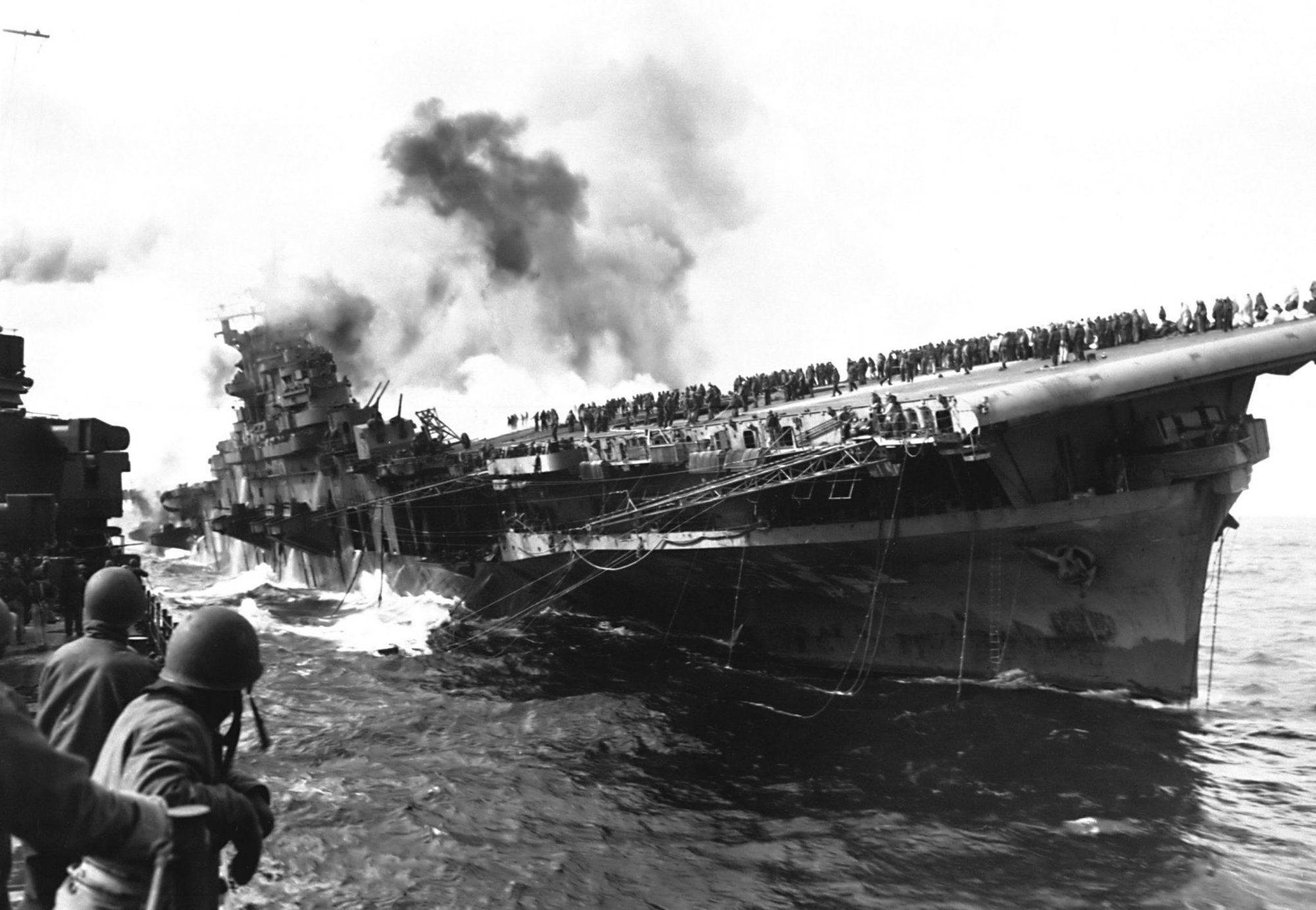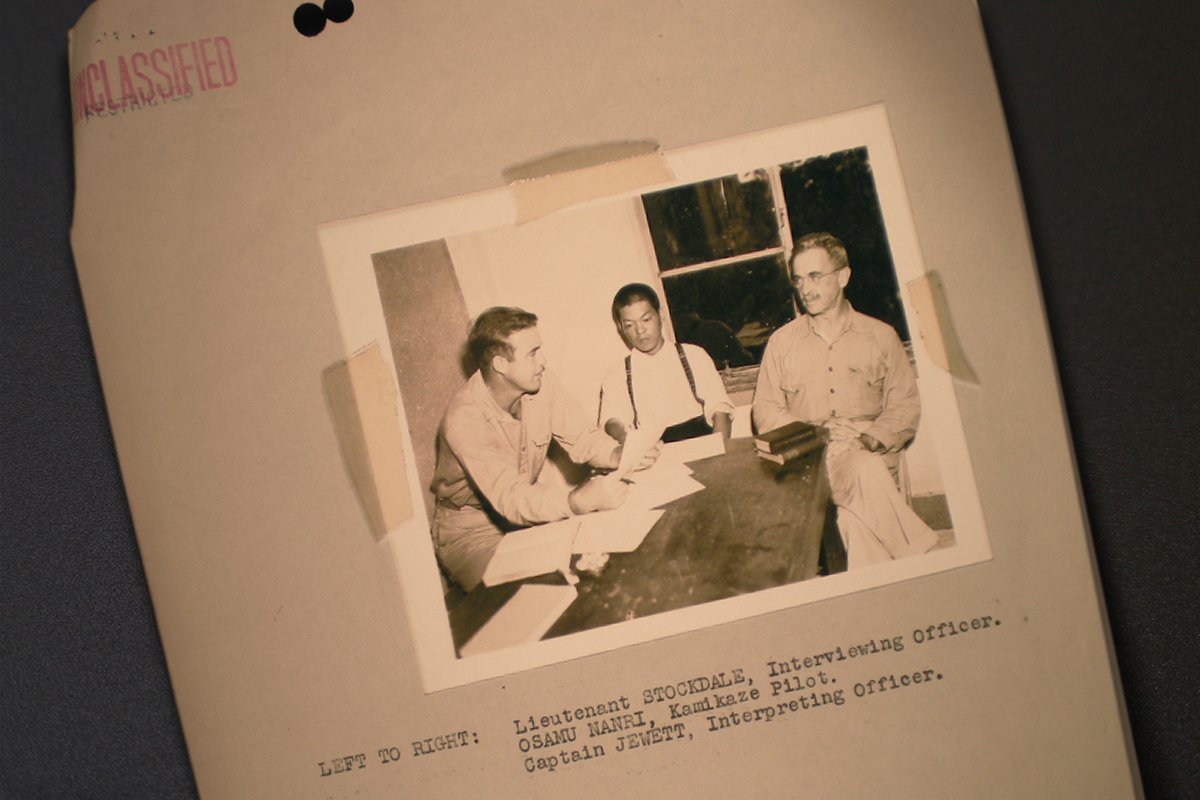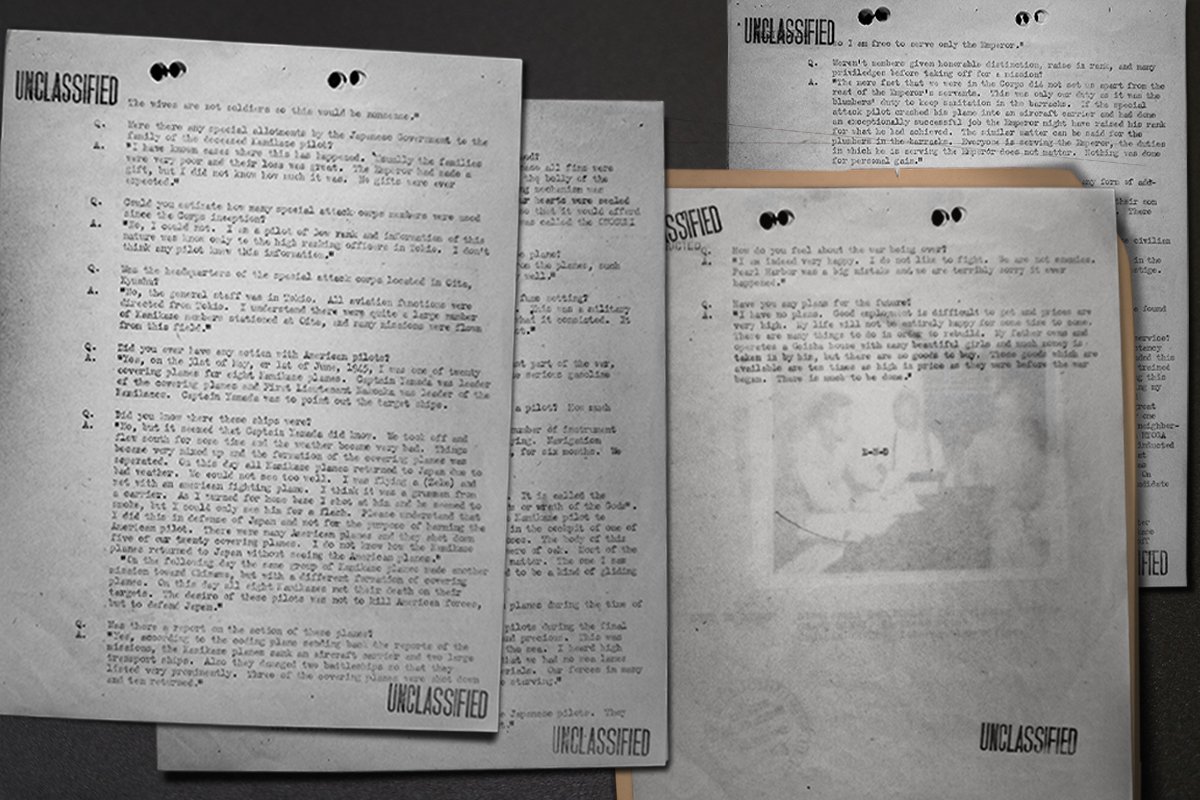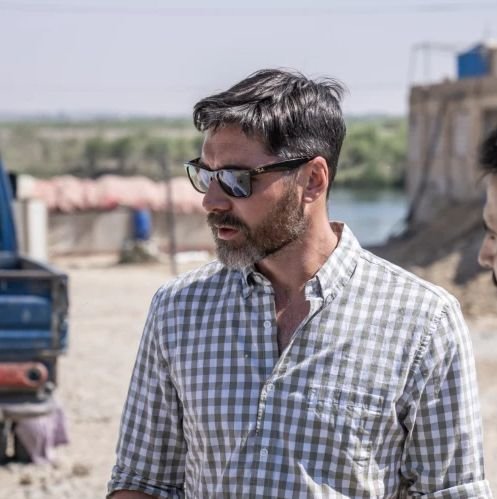
USS SANTA FE lays alongside of USS FRANKLIN rendering assistance after carrier had been hit and set afire by a Japanese dive bomber. March 1945. (Navy) Exact Date Shot Unknown NARA FILE #: 080-G-273880 WAR & CONFLICT BOOK #: 979
They picked up the young man at the train station in Sasebo. They had been looking for him or one of his kind for days. There were men with guns standing by, but he was cooperative. His former general had been in on it, anyway.
They brought him to the airbase in Omura. It was a major aircraft hub during the war, but the US Marines owned it now. Marine Fighting Squadron Three Fourteen. They set him in a small room by a window, an ashtray and a Japanese-English dictionary on the table.
“What is your name, rank and branch of service?” asked Lt. Stockdale.
“Osamu Nanri. I am a first-class petty officer of the Japanese Naval Air Force,” the young man replied.
The lieutenant was big, square-jawed, athletic. The older, gray-haired, bespectacled man did the translation, Capt. Jewett.
“Are you a member of the Kamikaze or Special Attack Corps?” the lieutenant asked. These teams were known in Japan as the Kamikaze/Shinpū Tokubetsu Kōgekitai, or “Divine Wind Special Attack Unit.”

“Yes,” Osamu Nanri said, “since the 22 of June 1945.”
He seemed small compared with the American officers, simple in a plain white shirt, buttoned to the throat, with dark suspenders. A faint smudge of hair shadowed his upper lip. The kamikaze pilot wasn’t yet 23 years old.
“How did a pilot become a member of the Kamikaze Corps?” the lieutenant asked.
“The Commanding Officer of the different airbases would observe the pilots at all times. The names of the Kamikaze candidates were drawn by the Commanding Officer of the airbase. I noticed that those whose names were drawn were always of fearless character and brave nerve. From these Kamikaze candidates a final selection was made and those would be members of the Kamikaze Corps.”
“Were there any volunteers for this Corps by those who were not selected?”
“Yes, there were some but they were few in number. It was felt that unless we were chosen it was not the Emperor’s wish that we become members.”
“Were there any inducements of rewards in order to make Kamikaze duty more desirous?”
“There were absolutely no inducements nor rewards at all for joining the Corps. We would still be fighting if the Emperor wished. Although my mother bore me I am the property of the Emperor for life, to carry out his wishes. To die for him is the highest honor to the Japanese solider. My duties in this life are to my parents and Emperor. During these times of grave stress my parents absolved me of any duties, so I am free to serve only the Emperor.”
Did the American officers cross or uncross their legs? Did they shift in their seats or make eye contact, eyebrows raised? So much the transcriptionist didn’t capture, so much the meeting notes and photos now in our National Archives don’t convey. Did the young man scratch at his close-cropped hair? Papers were spread over the heavy wood table. Just beyond the windowpane, outside, it rained.
“Weren’t members given honorable distinction, raise in rank, and many privileges before taking off for a mission?”
“The mere fact that we were in the Corps did not set us apart from the rest of the Emperor’s servants. This was only our duty as it was the plumbers’ duty to keep sanitation in the barracks. If the special attack pilot crashed his plane into an aircraft carrier and had done an exceptionally successful job the Emperor might have raised his rank for what he achieved. The similar matter can be said for the plumbers in the barracks. Everyone is serving the Emperor, the duties which he is serving the Emperor does not matter. Nothing was done for personal gain.”
Did they offer him a cigarette?
“Can you give an account of your training since you entered the service?”

“I attended high school in Sasebo with the expectancy of studying law at Tokyo Imperial University, but the war ended this plan. I joined the Japanese Navy Air Corps in January 1943. I trained an entire year before I actually started to learn flying. During this time I spent all of my energies in learning from books and getting my body into perfect physical fitness. We ran and wrestled and did calisthenics every day until we were almost exhausted. It was great enjoyment. I [was] twenty years old and this was great fun. Everyone liked the training. […] From June 1944 to the end of the war I was stationed at Mitajiri in Yamaguchi Ken near Hiroshima. Most of the time I was flying a twin-engine bomber and a single engine [fighter]. On 22 June 1945 my name was drawn by lot and I became a Kamikaze candidate and shortly thereafter I was an actual member.”
“Did you continue to fly a bomber even as a Kamikaze pilot?”
“No, during the entire month of July I flew a single engine fighter […] they were used almost entirely for Kamikaze work in the last phase of the war. All machine guns were taken off the Kamikaze planes. All armament was removed making them as light as possible.”
The Allies feared that single-engine fighter — the Zeke, or Zero — the Mitsubishi Zero A6M2 Reisen, especially early in the war, when it was the fastest plane in the fight. Zeros cut open the sky over Pearl Harbor, escorting the bomber and torpedo planes without a single loss, downing the few American fighters that made it off the ground. American engineers surpassed them in performance design, but soon after the Zeros were stripped for speed and packed with a fixed 550-pound bomb.

“When did you expect to make your mission?”
“The date for my mission was set on the 21st of August 1945. I was told that there would be others, but never found out who they were. The target was to have been a battleship at Okinawa.”
“Did you know there was a battleship at Okinawa?”
“No, but everyone said it would be there. Everyone said there would be many of them there. Our pilots returning from Okinawa always said that there were all types of ships there.”
“Did you have any photo coverage of Okinawa?”
“Not since April 1945.”
“What was your greatest fear?”
“The same fear that all Kamikazes had — missing the target.”
Regular service aircraft often accompanied the kamikazes. They aided navigation in bad weather and engaged American fighters if the suicide squad was discovered. The regulars would spearhead the attack on waiting ships, drawing antiaircraft fire. They were decoys and would turn back when the Kamikaze pilots found a hole in the anti-air coverage and started their high-speed dive.
“Were the Kamikaze planes ever loaded with just enough gas to get to the target?”
“Yes, but this was done to preserve precious gasoline and not to insure the pilot would not return. On cloudy days when the weather might completely obscure the target enough gasoline was always given so that the Special Attack planes could return to home field.”
Osamu Nanri turned and looked out the window. The transcriptionist noted it on her pad. The driving rain pounded the earth. His family owned a geisha house in Tokyo, but still he worried about money. He worried about telling his interrogators of the American plane he shot in June and how he watched the bullets hit the tail. It was far away, but he thought he saw smoke. It was his only combat mission. Capt. Yamada had said he could find the American fleet, but the weather was too thick. The weather turned around his group of 20. He would tell them this eventually. He would come to tell them how he shot at an American fighter, while turning home toward Japan. He would say he loved his emperor. He did it for his emperor. “Nothing personal,” he’d say, already America was seeping into the language of Japan these few months after the war. Pearl Harbor was a mistake, he’d say, but he loved his Emperor and his country. The rain outside did not relent.
“We have had much rain after the war’s end, during the war, very little,” Osamu Nanri said. “It is surely the weeping of the Gods.”
Editor’s note: Before kicking off a freelance writing career, the author spent a few years in graduate school researching World War II. This story about a kamikaze pilot comes from an unpublished interview and supporting documents Michael R. Shea found in the paper files at the National Archives in College Park, Maryland.

Shea is the senior editor at Free Range American, plus an itinerant freelancer for USA Today and Men’s Journal, among others. In July 2021, Gun Digest published his first book, Rimfire Revolution: A Complete Guide to Modern .22 Rifles. He holds an MFA in nonfiction writing from Columbia University. He once tanned a deer hide in an apartment bathroom. His wife was not pleased.
BRCC and Bad Moon Print Press team up for an exclusive, limited-edition T-shirt design!
BRCC partners with Team Room Design for an exclusive T-shirt release!
Thirty Seconds Out has partnered with BRCC for an exclusive shirt design invoking the God of Winter.
Lucas O'Hara of Grizzly Forge has teamed up with BRCC for a badass, exclusive Shirt Club T-shirt design featuring his most popular knife and tiomahawk.
Coffee or Die sits down with one of the graphic designers behind Black Rifle Coffee's signature look and vibe.
Biden will award the Medal of Honor to a Vietnam War Army helicopter pilot who risked his life to save a reconnaissance team from almost certain death.
Ever wonder how much Jack Mandaville would f*ck sh*t up if he went back in time? The American Revolution didn't even see him coming.
A nearly 200-year-old West Point time capsule that at first appeared to yield little more than dust contains hidden treasure, the US Military Academy said.












